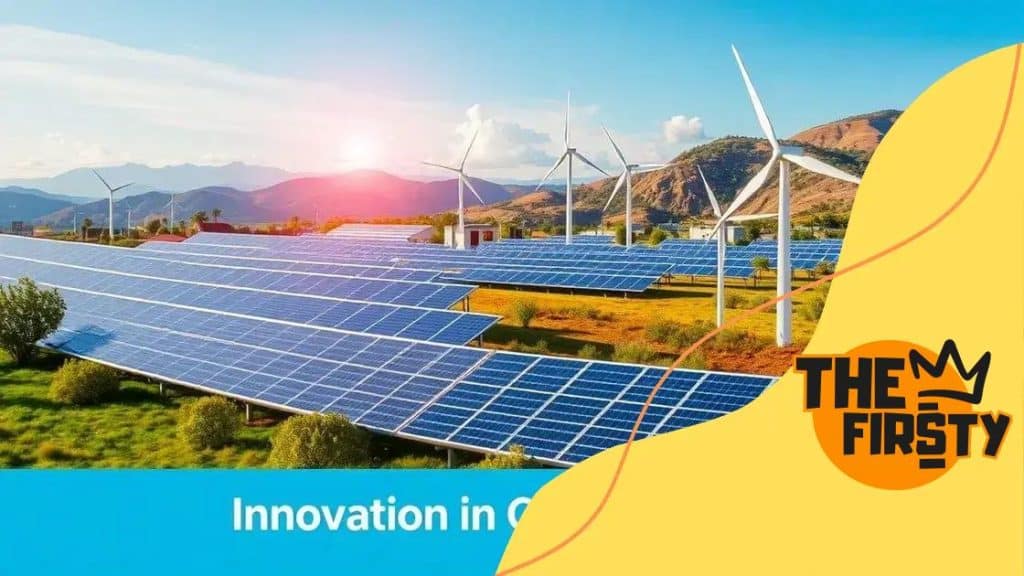Advancements in clean energy tech and its economic potential

Anúncios
Advancements in clean energy tech are revolutionizing the economy by creating jobs, reducing costs, and promoting sustainability through innovative solutions like solar, wind, and energy storage technologies.
Advancements in clean energy tech are not just about protecting the planet; they hold immense economic potential. Curious about how these innovations can reshape our future? Let’s dive into the details.
Anúncios
The current state of clean energy technologies
The current state of clean energy technologies reflects a remarkable shift towards sustainability. With advancements such as solar, wind, and hydroelectric power, we are witnessing a transformation in how energy is produced and consumed.
Innovative Technologies
New technologies are emerging, making clean energy more efficient and affordable. For instance, solar panels are now capable of converting sunlight into electricity with greater efficiency. Wind turbines are also becoming taller and more powerful, capturing more energy from the wind.
- Improved solar panel designs
- Advanced wind turbine technology
- Energy storage solutions
- Smart grid systems
Furthermore, energy storage technologies, such as batteries, are essential for managing the intermittent nature of renewable sources. These batteries allow for energy to be stored and used when it is needed most. This development plays a crucial role in increasing the reliability of clean energy.
Anúncios
Global Adoption
Countries around the world are ramping up their efforts to adopt clean energy technologies. For example, nations like Denmark and Germany are leading the way with aggressive policies to integrate renewable energy into their grid systems. This trend is not just limited to developed nations; even emerging economies are investing in clean energy.
In addition, the shift to clean energy technologies is creating new jobs and economic opportunities. As industries evolve to meet demands for sustainable energy, jobs in manufacturing, installation, and maintenance are rapidly increasing.
Key Challenges
Despite the progress, several challenges remain. Integrating clean energy technologies into existing infrastructures can be complicated. There is also the ongoing need to reduce costs to make these technologies accessible for everyone.
- Infrastructure adaptation
- Cost reduction efforts
- Regulatory hurdles
- Market fluctuations
Overall, the current landscape for clean energy technologies is promising. As innovations continue to emerge and global efforts increase, we can expect to see a more sustainable energy future.
Economic benefits of clean energy adoption
The economic benefits of clean energy adoption extend far beyond environmental improvements. By shifting to renewable sources, communities can experience significant financial advantages.
Job Creation
One of the most immediate benefits is job creation. As clean energy sectors grow, they generate numerous employment opportunities. These jobs are often in manufacturing, installation, and maintenance, providing a boost to local economies.
- Growth in renewable energy jobs
- Long-term career opportunities
- Local workforce development
- Enhancement of technical skills
Moreover, clean energy jobs tend to be more resilient during economic downturns. Workers in this field are vital to the ongoing transition towards sustainable energy solutions.
Cost Savings
Switching to clean energy also leads to substantial cost savings for individuals and businesses. Renewable energy sources, such as wind and solar, have lower long-term costs compared to fossil fuels. Once installed, these systems can provide free energy for years, substantially reducing monthly bills.
Additionally, governments and agencies often provide incentives for adopting renewable technologies. Tax credits, rebates, and grants can defray the initial setup costs, making clean energy even more appealing.
Energy Independence
Economies that embrace clean energy technologies can also improve their energy independence. By utilizing local resources like sunlight and wind, countries reduce their reliance on imported fuels, enhancing their energy security. This shift can stabilize energy prices and protect against market fluctuations.
With local production comes the potential for investment in infrastructure. Communities can develop facilities for energy generation, storage, and distribution. This development not only supports local economies but also contributes to a more resilient energy grid.
Environmental and Health Savings
Adopting clean energy also results in less pollution, which translates to health benefits. Cleaner air leads to fewer respiratory issues and healthcare costs. As we reduce our carbon footprint, we improve overall public health, saving millions in healthcare expenses.
- Decreased healthcare costs
- Improved air quality
- Long-term public health benefits
- Lower costs for pollution mitigation
In summary, the economic benefits are clear. Clean energy adoption offers job creation, cost savings, energy independence, and environmental improvements that positively impact society as a whole.
Challenges facing clean energy advancements

Challenges facing clean energy advancements are significant but not insurmountable. As we transition towards a more sustainable future, it’s essential to recognize the hurdles we must overcome.
Infrastructure Limitations
One major challenge is the existing infrastructure. Much of our current energy systems are built around fossil fuels. This makes it difficult to integrate new clean energy sources effectively. Upgrading power grids to accommodate renewable energy is costly and time-consuming.
- Need for advanced grid technology
- Investment in updated infrastructure
- Coordination between energy providers
- Balancing energy loads
Additionally, energy storage systems are essential for managing renewable sources like solar and wind. Without reliable storage, the variability of these energies can lead to energy shortages.
Economic Factors
Economic factors also pose a challenge. The initial costs for installing renewable energy systems can be high. Many individuals and businesses may hesitate to invest due to upfront expenses.
Moreover, traditional energy sectors, which have significant financial backing, may resist the transition. This can delay the adoption of cleaner technologies, even when there are clear long-term savings.
Regulatory Barriers
Regulatory barriers can further complicate progress. Governments play a crucial role in shaping energy policies. However, inconsistent regulations can create confusion, hindering investments in clean energy projects.
- Inconsistent policies at local levels
- Lack of incentives for clean energy adoption
- Complex permitting processes
- Regulatory uncertainties
To move forward, regulations need to be clear and supportive, ensuring a smoother pathway for new energy developments.
Public Awareness and Acceptance
Public awareness is another challenge. Many people are still unfamiliar with the benefits of clean energy technologies. Changing perceptions takes time and requires extensive education and outreach.
Building community support is essential for local projects, as public resistance can stall developments. Engaging with communities and providing clear information can help in this regard.
Despite these challenges, the push for clean energy is growing stronger. With continued innovation and support from all sectors, we can overcome these obstacles.
Future trends in clean energy technology
Future trends in clean energy technology are vital for shaping a sustainable world. Innovations are rapidly transforming the energy landscape, providing new solutions to meet demand.
Smart Grids
One significant trend is the development of smart grids. These advanced energy systems use technology to manage electricity flow efficiently. With smart grids, energy consumers can monitor usage, contributing to energy savings and overall efficiency.
- Real-time energy monitoring
- Improved energy distribution
- Enhanced integration of renewable sources
- Potential for localized energy production
Smart grids facilitate the integration of various energy resources, making it easier to use renewables like wind and solar.
Energy Storage Solutions
Energy storage technologies are also progressing. As renewable energy production can be variable, effective storage solutions are essential. Innovations in battery technology will make storing energy more feasible and affordable.
For example, advancements in lithium-ion batteries and other energy storage methods help balance energy supply and demand. This ensures that clean energy can be utilized when it is most needed, making systems more reliable.
Decentralized Energy Systems
Another emerging trend is the shift towards decentralized energy systems. Instead of relying solely on large power plants, communities are exploring local energy production. This includes solar panels on homes, wind turbines, and community energy projects.
Decentralization empowers communities and enhances energy security, as they can produce their own electricity. This shift reduces the reliance on traditional grid systems and allows for greater resilience against outages.
Integration of Artificial Intelligence
The integration of artificial intelligence (AI) into clean energy technologies is also notable. AI can optimize energy use, predict consumption patterns, and improve efficiencies in energy systems.
- Automated energy management
- Predictive maintenance for equipment
- Demand-response systems
- Enhanced energy forecasting
By leveraging AI, energy providers can enhance reliability and minimize waste, resulting in a more sustainable energy future.
As these trends develop, they provide an optimistic outlook for the future of clean energy. The focus on sustainability will drive innovations that not only address current challenges but also pave the way for a cleaner, more efficient world.
Case studies of successful clean energy initiatives
Case studies of successful clean energy initiatives demonstrate the effectiveness of renewable technologies in real-world applications. These examples highlight how communities and organizations are embracing clean energy solutions.
Solar Adoption in Community Projects
One excellent example is the solar energy project in Lancaster, California. This city has implemented a plan to place solar panels on rooftops throughout the community. This initiative not only produces clean energy but also helps reduce energy costs for residents.
- Over 1,000 rooftops equipped with solar panels
- Significant reduction in energy bills for families
- Promotion of local jobs in the renewable sector
- Long-term sustainability benefits for the environment
Such projects encourage other cities to explore similar solar initiatives, showcasing the potential for widespread adoption of clean energy.
Wind Farms Leading the Way
Another notable case is the offshore wind farm in Block Island, Rhode Island. This was the first commercial offshore wind farm in the United States and has set an example for future developments.
The wind farm now provides about 90% of the island’s electricity needs. It highlights how wind energy can play a crucial role in reducing dependence on fossil fuels. Furthermore, it contributes to job creation in construction and maintenance of the turbines.
- First commercial offshore wind farm in the U.S.
- Providing renewable energy to the island
- Boosting local economies through job creation
- Reducing greenhouse gas emissions significantly
Such initiatives are essential for demonstrating the viability of wind energy as a key component of the energy mix.
Innovations in Energy Storage
Innovative solutions in energy storage are also pivotal. The Tesla Gigafactory is a significant example of how large-scale battery production can transform the energy landscape. This facility in Nevada produces batteries designed for electric vehicles and renewable energy storage.
By making energy storage more accessible, this initiative supports the growth of renewable energy by allowing for energy to be stored and used when needed. This improves the overall reliability of clean energy systems.
- Mass production of lithium-ion batteries
- Support for electric vehicle market growth
- Enhanced grid stability with energy storage solutions
- Reduction of dependence on fossil fuels through stored energy utilization
The success of such initiatives points to a positive future for clean energy, encouraging both local and national governments to invest in sustainable technologies.
FAQ – Frequently Asked Questions about Clean Energy Initiatives
What are clean energy initiatives?
Clean energy initiatives refer to projects and programs that promote the use of renewable energy sources like solar, wind, and hydroelectric power to reduce dependence on fossil fuels.
How do clean energy initiatives benefit the economy?
These initiatives create jobs, lower energy costs, and stimulate local economies by encouraging investment in sustainable technologies.
What are some successful examples of clean energy projects?
Examples include the solar panel project in Lancaster, California, and the offshore wind farm in Block Island, Rhode Island, both of which showcase effective clean energy solutions.
What challenges do clean energy initiatives face?
Challenges include infrastructure limitations, high initial costs, regulatory barriers, and the need for public awareness and acceptance.





